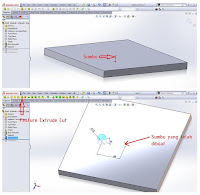Step by Step make a Projected Sketch on Sketch
1. Create a sketch using the two pieces of the plane perpendicular to each other
Create as an example in figure 1a & 1b
2. Select the menu Projected (Insert ==> Curve ==> Projected)
3. Select the type Projection Sketch on Sketch, select sketch 1a and 1b on the box
sketch choice. Select OK (green check mark)
4. The result will look like the figure 4
5. If we use to sweep the result will look just as figure 5
You can project a sketched curve onto a model face to create a 3D curve. You can also create a 3D curve that represents the intersection of two extruded surfaces generated by creating sketches on two intersecting planes.
You can preselect items before you click Project Curve . If you preselect items, SolidWorks attempts to select the appropriate type of projection .
You can right-click in the graphics area and select a projection type from the
shortcut menu. When you have selected enough entities to create a projected curve, the OK pointer appears. Right-click to create the projected curve.
To project a curve:
Click Project Curve on the Curves toolbar, or Insert, Curve, Projected.
The Projected Curve PropertyManager appears.
Under Selections, set Projection Type to one of the following:
Sketch on Faces
Sketch on Sketch
A preview of the projected curve appears.
Click OK to create the projected curve, or Cancel to cancel the transaction.



















